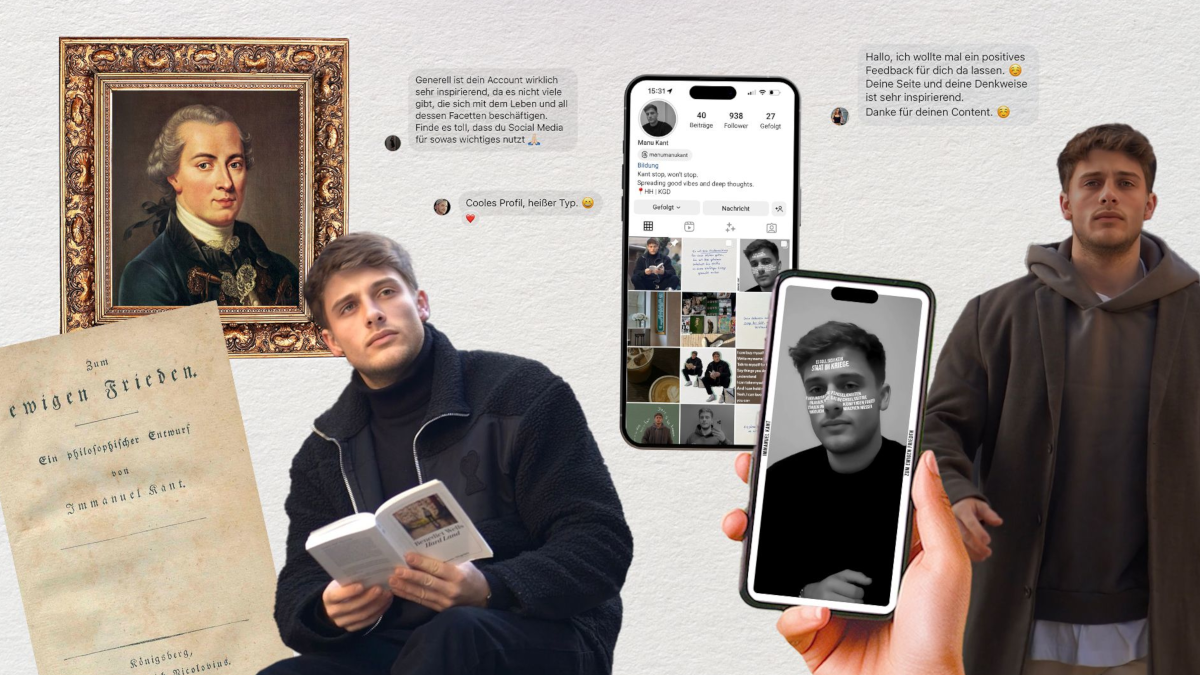In this interview MediaCat Magazine speak to Robert Andersen, MD and Managing Creative Director at Jung von Matt CREATORS, about their project to use AI to bring to life German philosopher Immanuel Kant, recreating him as a 23-year-old influencer.
Immanuel Kant is probably less well known by English speaking audiences than German ones. Can you tell us about him?
Immanuel Kant was a central figure in modern philosophy and a cornerstone of German Enlightenment. Born in 1724 in Königsberg, East Prussia, Kant is best known for his work in epistemology (the theory of knowledge), ethics, and aesthetics. His ‘Critique of Pure Reason’ investigated the limitations and capacity of reason itself. He also developed the concept of ‘Transcendental Idealism’, which argues that our experiences are fundamentally shaped by cognitive structures. Kant’s philosophy places a great emphasis on human rationality and the belief that rational beings can understand and shape the world they occupy.
What makes him relevant today?
Kant’s ideas continue to permeate contemporary philosophical and ethical discussions. His moral philosophy, often summarized by the ‘Categorical Imperative’, forms the groundwork for many ethical theories used today. Kant’s focus on rationality, freedom, and moral duty has applications in everything from legal systems to artificial intelligence. Given today’s scenario where we grapple with ethical issues surrounding technology, climate change and social inequality, the injection of Kantian principles — such as universally applicable moral laws — can provide practical guidance.
His return as an AI-powered Instagram influencer certainly introduces Kant’s concepts to a broader audience, encouraging global philosophical debates. The idea of Kant reborn as an AI Influencer is an innovative way of sparking conversations about the interpretations of his philosophy in today’s digital era. By bringing his wisdom into the 21st century, we hope to encourage deeper thinking about the complex questions that govern our society and individual lives.
What ethical considerations were there in bringing a historical figure back to life as an influencer?
Bringing a figure like Kant to life as a modern-day influencer certainly required meticulously considering several ethical issues:
1. Respect for Kant’s intellectual property rights and dignity: It was essential to ensure that Kant’s persona and ‘voice’ were recreated respectfully, accurately reflecting his philosophies and beliefs. Misrepresenting his ideas or distorting his moral and philosophical stances was a clear ethical boundary we set not to cross.
2. Historically accurate representation: We were aware that every piece of content published needed to be consistent with Kant’s philosophical concepts and beliefs. Simplifying Kant’s complex and profound concepts for social media engagement shouldn’t lead to their distortion or misinterpretation.
3. Influence and manipulation concerns: With any influencer, there’s potential for public opinion to be swayed or manipulated, and the same consideration applies to Kant’s AI recreation. We aimed to maintain transparency and honesty in all posts, highlighting the educative intention behind the project instead of misleading audiences. The primary goal of this project was to encourage philosophical discussions and provide a fresh perspective on classic philosophy in a modern, interactive way. We respected Kant’s legacy and ensured that these ethical considerations guided each step of Kant’s AI development and content creation.
Can you walk us through the technical process of creating ‘Manu’?
To create a convincing AI-based social media presence, we leveraged a wide range of generative AI technologies to create a face, voice, engaging posts and videos, bringing it all together on our Instagram profile. We used Stable Diffusion XL to generate a face that is inspired by Immanuel Kant’s most prominent facial features, and also catches the eyes when scrolling through your timeline. In the process, we created dozens of different faces, until we finally found our optimal Manu Kant.
To create the voice of Manu, we cloned the voice of real influencer Ole Liebl (with his permission, of course) and used the text-to-speech service of Elevenlabs. In a great collaborative effort, Ole created the perfect training material to clone his voice.
We needed to make posts that were both engaging for the target audience and true to the philosophy of Kant. To achieve that we created a ChatGPT Assistant that we fine-tuned with in-context-learning to match the textual style we wanted, and augmented its pre-trained knowledge with several documents containing specific details on the life and philosophy of Immanuel Kant. With Sora not being released yet, creating realistic and convincing videos remains somewhat out of reach for current AI methods. Also, we had already generated a face for Kant that we liked, and wanted to star in all our videos. So we relied on a hybrid approach, where we first filmed real scenes with one of our employees. Then, we used our own face swapping tools based on open source technology (such as OpenCV) to map Manu’s face onto our stand-in. This way, we realized our creative vision for Manu while producing believable content.
Manu is young, but Kant’s most influential works were written towards the end of his life. What challenges did you face ensuring the AI-generated content remained true to his philosophies whilst appealing to Gen Z audiences?
Creating content that communicated Kant’s complex philosophies while keeping it engaging and accessible for a Gen Z audience was indeed a challenging task. Here are some notable difficulties and our strategies to overcome them:
1. Simplicity versus complexity: Kant’s philosophical ideas are notoriously complex, but social media content typically thrives on simplicity and quick consumption. Striking the right balance involved distilling Kant’s thoughts into digestible, bite-sized content without losing the essence and depth.
2. Contextualising Kant’s ideas: We needed to present Kant’s 18th-century ideas in modern and relatable contexts. Our strategy was to draw connections between Kant’s principles and contemporary issues of interest for Gen Z — social inequality, climate change, digital privacy, and more.
3. Engaging visuals: To attract and retain the attention of a younger audience, we incorporated visually appealing elements like illustrations, graphics, and short videos.
4. Language and tone: We aimed to use a conversational yet respectful tone of voice in the content. The language had to be comprehensible for younger audiences, avoiding dense philosophical jargon.
5. Educational and entertaining: We followed an ‘edutainment’ approach, combining education with entertainment, to make the learning process enjoyable. Our goal throughout the process was to inspire a younger generation to explore philosophical concepts, promoting critical thinking and fruitful discussions on various societal and individual issues.
How about the content of the Manu posts? For example, how did you come up with the idea to use the Miley Cyrus song ‘Flowers’ to explain Kant’s philosophy?
The goal of ‘Manu’ was to make Kant’s philosophy relatable to a younger audience. Pop culture references, like Miley Cyrus’ song, are a universal language for this demographic. This song, with its themes of self-realisation and personal freedom, resonates well with Kant’s ideologies. By bridging pop culture and philosophy, we aim to spark interest and make philosophy more accessible and digestible. The approach is all about connecting the resonances between pop culture and philosophy, making learning both entertaining and engaging.
What were the reactions from the academic community and Kant enthusiasts? Has there been any notable criticism or praise?
Yes, indeed, we’ve received a variety of feedback, notably through direct messages from our followers. This feedback has been invaluable to help us understand how well the content is being received and what adjustments we can make to improve it. Many in the academic community and Kant’s enthusiasts have commended the project, noticing an increase in accessibility and relatability of philosophy to younger audiences.
However, the reactions have not been solely positive. Some have expressed concerns regarding the potential of oversimplification of Kant’s works and misinterpretations due to the format we’re using.
It’s a new venture, and these responses are helping shape it. Our goal has always been to strike a balance between staying true to Kant’s works and making philosophy more digestible for the youth, and we continue to appreciate the feedback on our attempt.

































